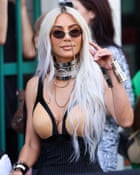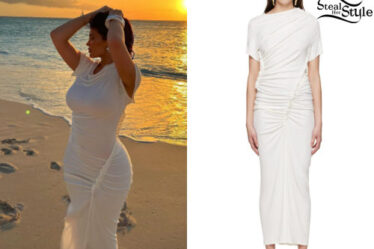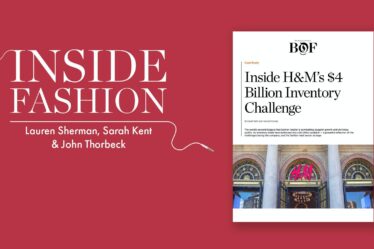
As Rishi Sunak and Liz Truss square up to become the next Tory leader, it’s not just what they say that is gaining column inches. Their sartorial statements also speak volumes.
Last week, stories on what the candidates wore had them in opposing corners – with vastly differing budgets. Truss’s £4.50 earrings from Claire’s Accessories were contrasted with Sunak’s big-budget style choices, including a £450 pair of Prada loafers, and a £3,500 bespoke suit.
If politicians’ clothes are always analysed – think of Theresa May’s quirky leopard kitten heels or Barack Obama’s can-do rolled-up sleeves – the debate around what Sunak and Truss wear comes with the backdrop of the cost of living crisis. It’s focused around price, and the status that these items attempt to signal. It raises the question: how do style status symbols work in 2022?
Even during a cost of living crisis, fashion’s expensive symbols of status retain power, and remain popular with consumers. Financial results for fashion brands were released for the first half of 2022 last week. Revenues were up 48% at Moncler, where a short down jacket with the bear logo on the sleeve costs £1,235. At conglomerate LVMH, which owns Louis Vuitton and Givenchy, revenues in the second quarter of 2022 were up 19%, with luxury bags credited. A classic Louis Vuitton Speedy with monogram is £1,030. Meanwhile, Sunak’s favourite, Prada, saw its first half sales rise 22%. Its popular Cleo shoulder bag – with Prada triangle logo – is £1,800.
“Clothing has been deeply embedded with status for millennia because clothing is a social language,” says Emma McClendon, fashion historian and author of Power Mode: the Force of Fashion. “It’s the way that we make our bodies socially legible.” The symbols shift over time. “The way that you show strength and power might be different in 2022 than 2016 or 2012,” she explains.
Status symbols of any moment are defined by what the dominant elite looks like. In the digital era, that is the Silicon Valley super-rich, figures who are more likely to be in hoodies and trainers than the suits of the traditional establishment. Mark Zuckerberg, hardly a style icon in the conventional sense, masterminded this shift. McClendon argues his casual outfits were “a really conscious thumbing his nose at the suited Wall Street sense of success. Because, ultimately, what this is about is how each given era or each given individual is trying to define success and power.”
Sunak has bought into the Silicon Valley definition. For photos of him working on the budget at the height of the pandemic in 2020, he was pictured in a hoodie from Californian brand Everlane, a choice intended to frame him as a poster boy of contemporary success and prosperity.
Discussion around status symbols also takes in class and who is “allowed” to wear these coveted items. This also changes over time. Twenty years ago, Danniella Westbrook was on the cover of the Sun in head-to-toe Burberry check, causing outrage – and the fashion house to reduce the amount of check it used for fear of alienating its upper-class customer base. Daniel Rodgers, a fashion writer who wrote about the impact of Westbrook’s outfit, says that the look would be less disruptive now. “It’s increasingly difficult to tell if someone’s middle class, working class or upper class because of the way that the internet and social media blurred all of those markers.”

He does, however, see women in the public eye still provoking outrage for stepping outside their perceived boundaries. “Kim Kardashian is an example,” he says. “Pre Kanye, when she was beginning to get dressed by luxury houses such as Givenchy, people were like, ‘why is this basically Page Three girl getting access to this?’ It really displaces a lot of people’s [ideas of] class. It’s something so embedded within us, so for someone to transgress those boundaries, for a lot of people, that’s offensive, [because it’s] not respecting the kind of natural order in the world.”
Signifiers are further complicated by the fact that status can now come from the “cool” and authenticity often tied up with working-class culture. “There are pop stars or public figures trying to pick up the tropes of the working class and align themselves with something that seems more authentic,” says Rodgers.
Rachel Worth, author of the 2020 book Fashion and Class, says this is not new. She points to the French revolution when “it became dangerous to be wearing high-class fabrics such as silk. While looking casual and working class became politically correct.”
Worth, whose forthcoming book is focused around sustainability, also argues that status now can come from signalling you are conscious of your carbon footprint. “These things go in cycles,” she says. “In the 19th century, secondhand was far superior, even for working people. It’s like we’ve come back to that.”
“It is fashionable to be a knowing consumer,” agrees Caroline Stevenson, head of cultural and historical studies at London College of Fashion, “to know where your clothing came from, to carefully curate your wardrobe and to show appreciation for the more refined things in life.”
In the public eye, this is either – as with the Duchesses of Cambridge and Sussex – demonstrated through rewearing outfits or – as with Carrie Johnson – renting an outfit. Last year, she wore a rented dress to marry the prime minister. In this context, Sunak’s and Truss’s conspicuous consumption of new items, whether fast fashion or high end, could be seen as bad form, in the same way that Kylie Jenner’s boast about using her private jet to travel 17 minutes between two Californian airports triggered her branding as a “climate criminal” in a viral tweet.
McClendon says that what the two candidates wear communicates different takes on status. If Sunak’s are “classic symbols of wealth – the bespoke suit, the designer duds”, Truss’s earrings are “a sort of reverse status [symbol] … There’s a sense of status, of power within a democratic system, representing the people.”
Charlie Porter, the author of What Artists Wear, believes Truss’s choice to wear fast fashion chimes with her cheap thrill policies. “[She] is campaigning to cut taxes for short-term feel-good benefit,” he says. “The promise is of more disposable income in the face of rising fuel and grocery bills. Disposable income usually means shopping. Shopping makes people feel good in the short term, often at the expense of what could do them good in the long term.” Sunak’s luxury items, meanwhile, “can be used to skewer the wealthy, while still being items of desire and aspiration”.
She adds: “I think we’re in a really complicated moment with wealth because there’s both the prolonged pandemic, inflation, the financial woes, but also sustainability. That makes aspiration really complicated.” Style status symbols are alive and well in 2022 but, as ever, it’s far from simple.



